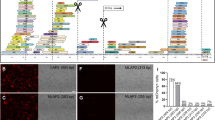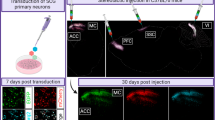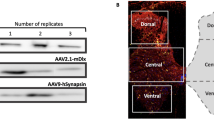Abstract
Vectors suitable for delivery of therapeutic genes to the CNS for chronic neurodegenerative diseases will require regulatable transgene expression. In this study, three self-regulating rAAV vectors encoding humanized green fluorescent protein (hGFP) were made using the tetracycline (tet)-off system. Elements were cloned in different orientations relative to each other and to the AAV internal terminal repeat (ITRs). The advantage of this vector system is that all infected cells will carry both the ‘therapeutic’ gene and the tet-regulator. To compare the efficiency of the vectors, 293T cells infected by each vector were grown in the presence or absence of the tet-analog doxycycline (dox). Cells were analyzed by flow cytometry for hGFP protein expression, and quantitative RT-PCR (QRT-PCR) for levels of hGFP mRNA and the tet-activator (tTA) mRNA. In the presence of dox, cells infected with one of the vectors, rAAVS3, showed less than 2% total fluorescent intensity and mRNA copy number than cells grown without dox. The other two vectors were significantly more leaky. Levels of tTA mRNA were not affected by dox. The S3 vector also displayed tight regulation in HeLa and HT1080 cells. To assess regulation in the brain, the S3 vector was injected into rat striatum and rats maintained on regular or dox-supplemented water. At 1 month after vector injection, numerous positive cells were observed in rats maintained on regular water whereas only rare positive cells with very low levels of fluorescence were observed in rats maintained on water containing dox. The QRT-PCR analysis showed that dox inhibited expression of hGFP mRNA in brain by greater than 99%. These results demonstrate that exceedingly tight regulation of transgene expression is possible using the tet-off system in the context of a self-regulating rAAV vector and that the specific orientation of two promoters relative to each other and to the ITRs is important. Regulatable vectors based on this design are ideal for therapeutic gene delivery to the CNS.
This is a preview of subscription content, access via your institution
Access options
Subscribe to this journal
Receive 12 print issues and online access
$259.00 per year
only $21.58 per issue
Buy this article
- Purchase on Springer Link
- Instant access to full article PDF
Prices may be subject to local taxes which are calculated during checkout






Similar content being viewed by others
References
Bjorklund A et al. Towards a neuroprotective gene therapy for Parkinson's disease: use of adenovirus, AAV and lentivirus vectors for gene transfer of GDNF to the nigrostriatal system in the rat Parkinson model. Brain Res 2000; 886: 82–98.
Bohn MC, Choi-Lundberg DL . Gene therapies for Parkinson's disease. In: Chiocca EA, Breakefield XO (eds). Gene Therapy for Neurological Disorders and Brain Tumors. Humana Press: Totowa, NJ, 1997, pp 377–396.
Bohn MC, Choi-Lundberg DL . Neurotrophic factor gene therapy for neurodegenerative diseases. Gene Ther Mol Biol 1998; 1: 265–277.
Davidson BL, Breakefield XO . Viral vectors for gene delivery to the nervous system. Nat Rev Neurosci 2003; 4: 353–364.
Gossen M, Bujard H . Tight control of gene expression in mammalian cells by tetracycline-responsive promoters. Proc Natl Acad Sci USA 1992; 89: 5547–5551.
Gossen M, Bonin AL, Bujard H . Control of gene activity in higher eukaryotic cells by prokaryotic regulatory elements. Trends Biochem Sci 1993; 18: 471–475.
Corti O et al. A single adenovirus vector mediates doxycycline-controlled expression of tyrosine hydroxylase in brain grafts of human neural progenitors. Nat Biotechnol 1999; 17: 349–354.
Hasan MT et al. Long-term, noninvasive imaging of regulated gene expression in living mice. Genesis 2001; 29: 116–122.
Urlinger S et al. Exploring the sequence space for tetracycline-dependent transcriptional activators: novel mutations yield expanded range and sensitivity. Proc Natl Acad Sci USA 2000; 97: 7963–7968.
Baron U, Bujard H . Tet repressor-based system for regulated gene expression in eukaryotic cells: principles and advances. Methods Enzymol 2000; 327: 401–421.
Bohl D, Heard JM . Modulation of erythropoietin delivery from engineered muscles in mice. Hum Gene Ther 1997; 8: 195–204.
Reiser J, Lai Z, Zhang XY, Brady RO . Development of multigene and regulated lentivirus vectors. J Virol 2000; 74: 10589–10599.
Yoshida Y, Hamada H . Adenovirus-mediated inducible gene expression through tetracycline-controllable transactivator with nuclear localization signal. Biochem Biophys Res Commun 1997; 230: 426–430.
Harding TC et al. Switching transgene expression in the brain using an adenoviral tetracycline-regulatable system. Nat Biotechnol 1998; 16: 553–555.
Rendahl KG et al. Regulation of gene expression in vivo following transduction by two separate rAAV vectors. Nat Biotechnol 1998; 16: 757–761.
McGee Saftner LH et al. Recombinant AAV-mediated delivery of a tet-inducible reporter gene to the rat retina. Mol Ther 2001; 3: 688–696.
Dugray A et al. Rapid generation of a tetracycline-inducible BCR-ABL defective retrovirus using a single autoregulatory retroviral cassette. Leukemia 2001; 15: 1658–1662.
Hofmann A, Nolan GP, Blau HM . Rapid retroviral delivery of tetracycline-inducible genes in a single autoregulatory cassette. Proc Natl Acad Sci USA 1996; 93: 5185–5190.
Watsuji T et al. Controlled gene expression with a reverse tetracycline-regulated retroviral vector (RTRV) system. Biochem Biophys Res Commun 1997; 234: 769–773.
Kafri T, van Praag H, Gage FH, Verma IM . Lentiviral vectors: regulated gene expression. Mol Ther 2000; 1: 516–521.
Ogueta SB, Yao F, Marasco WA . Design and in vitro characterization of a single regulatory module for efficient control of gene expression in both plasmid DNA and a self-inactivating lentiviral vector. Mol Med 2001; 7: 569–579.
Kojima H et al. Adenovirus-mediated transduction with human glial cell line-derived neurotrophic factor gene prevents 1-methyl-4-phenyl-1,2,3,6-tetrahydropyridine-induced dopamine depletion in striatum of mouse brain. Biochem Biophys Res Commun 1997; 238: 569–573.
Aurisicchio L et al. Regulated and prolonged expression of mIFN(alpha) in immunocompetent mice mediated by a helper-dependent adenovirus vector. Gene Therapy 2001; 8: 1817–1825.
Fitzsimons HL, McKenzie JM, During MJ . Insulators coupled to a minimal bidirectional tet cassette for tight regulation of rAAV-mediated gene transfer in the mammalian brain. Gene Therapy 2001; 8: 1675–1681.
Xu R et al. Quantitative comparison of expression with adeno-associated virus (AAV-2) brain-specific gene cassettes. Gene Therapy 2001; 8: 1323–1332.
Haberman RP, McCown TJ, Samulski RJ . Inducible long-term gene expression in brain with adeno-associated virus gene transfer. Gene Therapy 1998; 5: 1604–1611.
Peel AL, Klein RL . Adeno-associated virus vectors: activity and applications in the CNS. J Neurosci Methods 2000; 98: 95–104.
Lo WD et al. Adeno-associated virus-mediated gene transfer to the brain: duration and modulation of expression. Hum Gene Ther 1999; 10: 201–213.
Grimm D, Kern A, Rittner K, Kleinschmidt JA . Novel tools for production and purification of recombinant adenoassociated virus vectors. Hum Gene Ther 1998; 9: 2745–2760.
Xiao X, Li J, Samulski RJ . Production of high-titer recombinant adeno-associated virus vectors in the absence of helper adenovirus. J Virol 1998; 72: 2224–2232.
Clark KR, Liu X, McGrath JP, Johnson PR . Highly purified recombinant adeno-associated virus vectors are biologically active and free of detectable helper and wild-type viruses. Hum Gene Ther 1999; 10: 1031–1039.
Zolotukhin S et al. Recombinant adeno-associated virus purification using novel methods improves infectious titer and yield. Gene Therapy 1999; 6: 973–985.
Flotte TR et al. Expression of the cystic fibrosis transmembrane conductance regulator from a novel adeno-associated virus promoter. J Biol Chem 1993; 268: 3781–3790.
Blesch A, Uy HS, Diergardt N, Tuszynski MH . Neurite outgrowth can be modulated in vitro using a tetracycline-repressible gene therapy vector expressing human nerve growth factor. J Neurosci Res 2000; 59: 402–409.
Paulus W et al. Self-contained, tetracycline-regulated retroviral vector system for gene delivery to mammalian cells. J Virol 1996; 70: 62–67.
Gallia GL, Khalili K . Evaluation of an autoregulatory tetracycline regulated system. Oncogene 1998; 16: 1879–1884.
Kaludov N, Handelman B, Chiorini JA . Scalable purification of adeno-associated virus type 2, 4, or 5 using ion-exchange chromatography. Hum Gene Ther 2002; 13: 1235–1243.
Veldwijk MR et al. Development and optimization of a real-time quantitative PCR-based method for the titration of AAV-2 vector stocks. Mol Ther 2002; 6: 272–278.
Kozlowski DA et al. Quantitative analysis of transgene protein, mRNA, and vector DNA following injection of an adenoviral vector harboring glial cell line-derived neurotrophic factor into the primate caudate nucleus. Mol Ther 2001; 3: 256–261.
Acknowledgements
We acknowledge Xuesong Wang, Jianping Xie for technical assistance in cell culture and histology, Lisa Tesch for her help in the FPLC preparation of rAAVS3 vector, and Juergen Kleinschmidt, and Mark Sands for providing the pDG and pBR322ITRs plasmids, respectively. The advice of Mark Sands for rAAV purification methods was also greatly appreciated. This work was supported by NIH Grants NS31957 and NS045309, the Walden W and Jean Y Shaw Foundation and the Medical Research Institute Council of Children's Memorial Hospital.
Author information
Authors and Affiliations
Rights and permissions
About this article
Cite this article
Jiang, L., Rampalli, S., George, D. et al. Tight regulation from a single tet-off rAAV vector as demonstrated by flow cytometry and quantitative, real-time PCR. Gene Ther 11, 1057–1067 (2004). https://doi.org/10.1038/sj.gt.3302245
Received:
Accepted:
Published:
Issue Date:
DOI: https://doi.org/10.1038/sj.gt.3302245
Keywords
This article is cited by
-
Regulation of Retinal Function but Nonrescue of Vision in RPE65-deficient Dogs Treated With Doxycycline-regulatable AAV Vectors
Molecular Therapy (2010)
-
Lack of humoral immune response to the tetracycline (Tet) activator in rats injected intracranially with Tet-off rAAV vectors
Gene Therapy (2010)
-
Controlling brain tumor growth by intraventricular administration of an AAV vector encoding IFN-β
Cancer Gene Therapy (2009)
-
Molecular therapy of obesity and diabetes by a physiological autoregulatory approach
Nature Medicine (2009)
-
Configurations of a two-tiered amplified gene expression system in adenoviral vectors designed to improve the specificity of in vivo prostate cancer imaging
Gene Therapy (2008)



